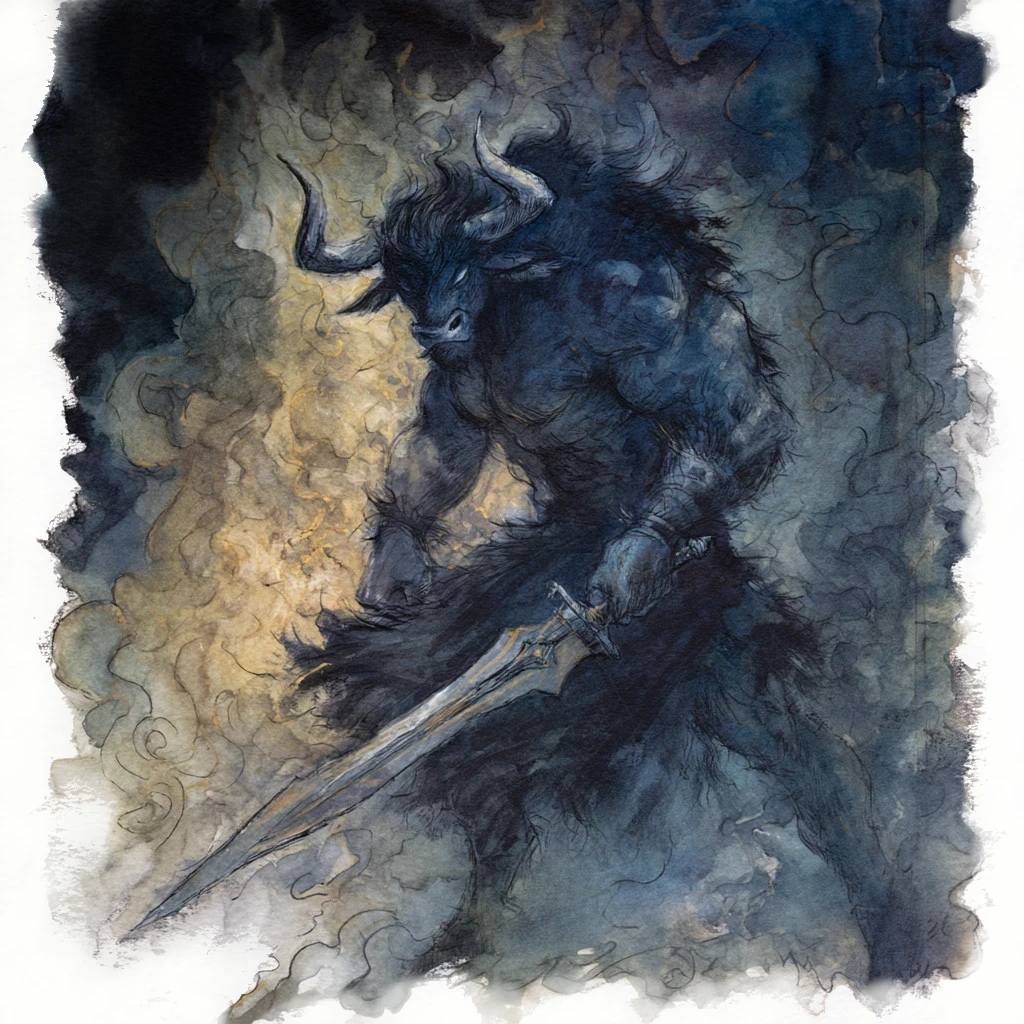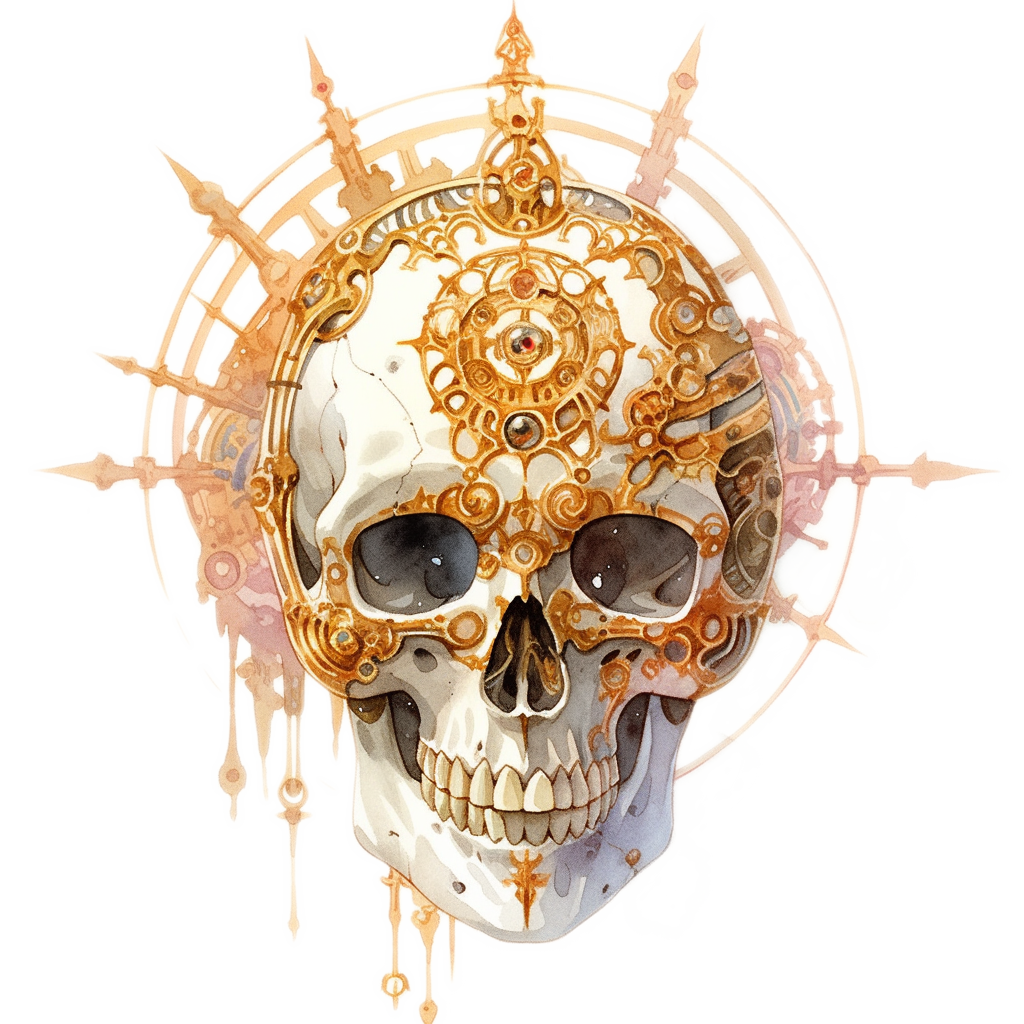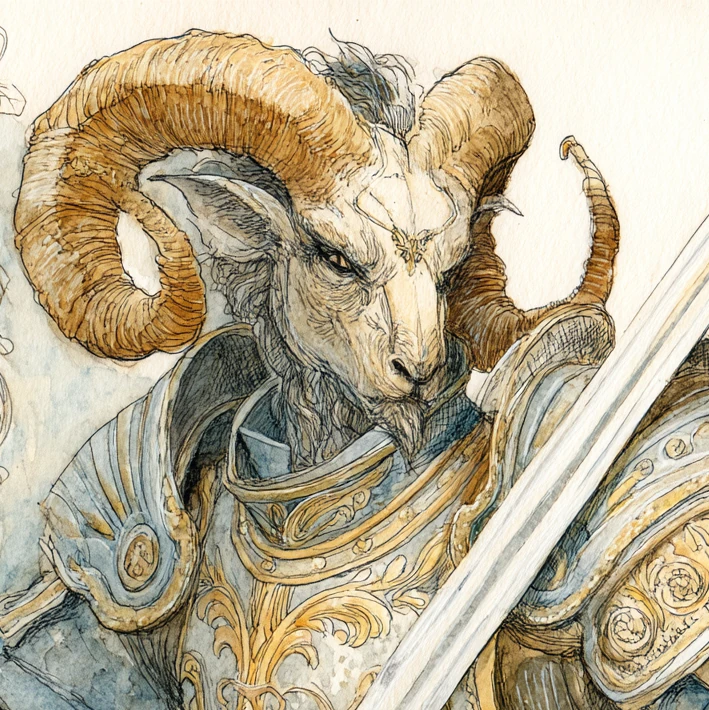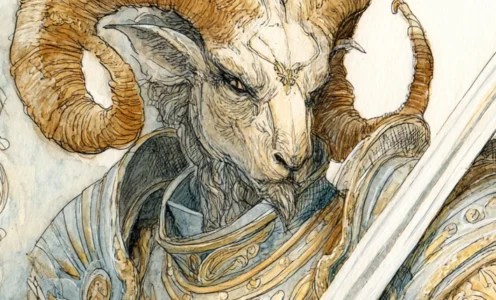Ramadeen

The ramadeen are embodiments of redemption’s promise. Their imposing ram-headed forms represent the belief that even the most unlikely of souls can potentially find salvation. These noble cutters serve as Mount Celestia’s emissaries to the darkest places in the multiverse, where their monstrous appearance allows them to walk where more conventionally attractive celestials might provoke instant hostility.
Ramadeen tower over most humanoids, standing half again as tall as the average human. Their bodies are powerfully muscled but graceful. They have the heads of rams, complete with magnificent spiralling horns. Their eyes burn with divine purpose—stern but not unkind, penetrating but not judgmental. The ramadeen combine martial prowess with diplomatic finesse. They seek to spread the message that no being is beyond salvation—all the while standing ready to defend that principle with gleaming blades and steely resolve.
When on campaign—which is virtually always—ramadeen wear gleaming armour that bears ornate motifs that represent the vistas of Mount Celestia. It seems to capture and reflect the dazzling light of Heaven itself. The distinctive shimmer of the metal comes from a forging process involving being quenched in the waters of the Shimmering River. Ramadeen shields usually display the insignia of their heavenly patrons or their chosen Path on Celestia. In order to defend themselves from baatezu and tanar’ri alike, ramadeen carry swords infused with silver, and their scimitars are forged from cold-iron.
When one of these cutters speaks, their voice commands attention without demanding it; it carries a subtle harmonic that hints at their empyreal nature without damaging mortal ears. They speak Celestial, Common, Abyssal and Infernal—the latter being essential for their work amongst fiends.
Divine Purpose and Mission
The ramadeen have carved themselves a unique niche in the celestial hierarchy. Where aasimon might inspire terror and archons might provoke instant aggression in the Lower Planes, ramadeen can move with relative freedom among societies dominated by evil races. Their appearance creates a bridge of familiarity that allows initial communication where other celestials might face immediate attack.
This specialised role makes them Mount Celestia’s primary agents for what the ramadeen call redemptive outreach—the active recruitment of Lower Planar bashers to the path of righteousness. Ramadeen operate in the dark corners of the planes, seeking out those rare individuals who question their society’s wicked ways. With patience and understanding that’s rarely seen among celestials, the ramadeen nurture those sparks of goodness, eventually helping worthy converts escape to begin new lives.
Beyond this primary mission, ramadeen serve as minor bureaucrats within the celestial hierarchy, particularly in matters relating to intercession. They can be found in the courts of the Underlands, where they advocate for mercy towards souls who show even the slightest potential for absolution. On Lunia, the ramadeen congregate in the burg of Redemption, which is a sanctuary for cutters who’ve turned over a new leaf and are trying to reform.
The Philosophy of Second Chances
Ramadeen philosophy can be distilled to a single powerful principle: Redemption is available to all who truly seek it. Chant goes that this stems directly from their own origins as transformed fiendish minotaurs who saw the light and abandoned evil during a raid on Mount Celestia. Having experienced conversion firsthand, they maintain that no being—not even fiend—is truly beyond salvation’s reach.
This belief manifests in their Doctrine of Eternal Possibility, which holds that the capacity for good exists within all sentient beings, though it may be buried beneath many layers of corruption, indoctrination, and spiritual damage. Ramadeen believe each soul contains an inextinguishable divine spark that can potentially be nurtured into flame, under the right circumstances.
Unlike many celestials who view fiends with divine contempt, the ramadeen approach them with what they call compassionate realism. They harbour no illusions about the difficulty of true redemption—indeed, they acknowledge that genuine transformations, especially among fiends, are exceedingly rare. Yet they refuse to abandon the possibility altogether, believing that to do so would contradict the fundamental nature of goodness itself.
This perspective sometimes puts them at odds with other celestials who favour more decisive action against evil. Ramadeen often serve as a moderating voice in celestial councils, advocating for approaches that leave room for potential redemption even while acknowledging the necessity of confronting evil directly.
Once a potential fiendish defector is identified, the real hard work begins. The ramadeen path to redemption is a three step process:
- Recognition—True redemption begins with honest self-recognition about one’s wicked nature and actions. Without this painful awareness, no meaningful change can occur.
- Restitution—Genuine redemption requires concrete actions to address the harm caused by a body, and begin to build a pattern of goodness. Words alone are not enough.
- Reconstruction—The final stage involves building a new identity founded on benevolence, creating a new understanding of the self and one’s purpose.
The ramadeen teach that these elements must occur in sequence, and that attempts to skip steps inevitably lead to false redemption. Their interactions with potential converts focus heavily on guiding them through these stages, sometimes over the course of years or even decades.
The Origin of the Ramadeen

Now, they might look like bariaur, but it turns out the first ramadeen were created from a much more unlikely source—the souls of fiendish minotaurs who participated in a raid on the Chambers of Repentance, seeking to break out a high-up from their cult of Baphomet worshippers. As these minotaurs descended upon the plane intent on desecration, they were overwhelmed by Lunia’s transcendent beauty. In a moment of clarity, several of the invaders recognized the hollow corruption of their demonic allegiance, and betrayed their fellow raiders.
This spontaneous conversion was initially met with skepticism by Ragathiel and the Congregation of Crusade. The turncoat minotaurs were subjected to numerous tests to verify the authenticity of their transformation. These tests, now codified as the Trials of the Horn, included acts of self-sacrifice, challenges to their newfound principles, and opportunities to return to evil ways. Those bloods who persevered were ultimately given the blessing of the Celestial Host and transformed into the first ramadeen, their minotaur forms refined into the noble ram-headed celestials known today.
Nowadays ramadeens are no longer created exclusively from redeemed minotaurs. Instead, they are formed directly from the fabric of Celestia itself, but with a unique spiritual composition. Each ramadeen represents a conglomeration of minor kindnesses and good deeds committed by creatures typically considered irredeemable—the hag who spared a child, the goblin who returned stolen goods, the troll who guided lost travellers rather than eating them. These acts, too small individually to counterbalance a life of evil, collectively gather together on the coast of the Silver Sea like a benevolent counterpart of the Mists of Sin and form the spiritual essence of new ramadeen. Having been formed either directly from redeemed evil or from the positive anomalies within evil societies, ramadeen possess an intimate understanding of evil’s allure and the difficulty of breaking free from its grasp.
Ramadeen Paragons
- Heldram the Battle-Sage — ramadeen paragon of confrontational mercy
- Kornath the Persistent — ramadeen paragon of subtlety and gradual persuasion
- Sundera Bridge-Builder — ramadeen paragon of redeeming communities
Canonical Sources: Miniatures Handbook [3e] p67. Stats can be found here [ 3e | PF1e ]
Other Sources: Inspired by the Creature Codex [PF1e]; Jon Winter-Holt. Canonwatch: The ramadeen are a relatively obscure race of celestials from D&D 3e with no canonical lore, which the Creature Codex turned into something really cool, and I’ve expanded upon that.



